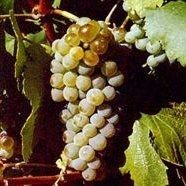More 2008 vintage reports from Italy and Spain

Reports from Rueda, Trentino and Montalcino follow.
Rueda
This predominantly white-wine region in Castilla y León has announced a record crop this year of 56 million kilos, with white grapes accounting for an overwhelming 95% of the harvest.
Although the vineyard area has increased by 13.4% (now up to 9,141 ha), the production growth is just 4.3% and average yields are down by about 8% on 2007 – with Viura and Palomino down almost 25%, though apparently this is also partly due to the damage caused in 2007 by pine voles.
The productive area is likely to increase by around 2,000 ha thanks to further planting in the last two years. New investment is focusing largely on the local Verdejo variety (pictured here). A small amount of red and rosé wine is also being produced, mainly from Tempranillo.
The Consejo Regulador of the Rueda DO described the 2008 harvest as follows. Once again, as in many parts of Europe, slow ripening seems to have been an important factor.
Harvest has been completely normal despite the fact it started later than usual (12 September) as the growth cycle was delayed due to the late budding, which was mainly caused by May and June rains and mild temperatures during almost all summer. For these reasons, grapes experienced a slow ripening, which is excellent for a good sugar-acidity balance of musts and a greater aromatic potential and a more balanced acidit in the wines.
Rain during the first fortnight of October fell when almost 80% of grapes were already harvested and the remaining were ready to be picked. As a result, they were not affected by any diseases, such as botrytis, and the sugar level of musts remained optimum.
85% of grapes was mechanically harvested (100% in case of Sauvignon Blanc). Over 40 harvesting machines were used in the area allowing for a significant level of nigh-time harvesting.
See Rueda today for Richard Hemming's tasting notes on a selection of Rueda wines from the 2007 vintage.
Trentino
Anselmo Martini, Cavit chief oenologist and winemaker, reports on a long growing season which had produced good levels of both sugar and acidity in the grapes harvested in this part of northern Italy.
The intermittent rainfall at the beginning of the summer gradually gave way to very dry and bright weather in late August and September, which was just what was needed to develop aromas, produce excellent sugar levels and ripen the grapes perfectly…a pleasant surprise for everyone!
The 2008 season has been a difficult one for our winegrowers, but we are convinced it will also be a highly satisfying one in terms of the quality of the wines produced. Rainfall was scarce during first few months of the year, which caused the water table and ground reserves to drop. Halfway through May however the rains became more intense, alternating with days of good weather which led to water reserves being replenished and enabled vegetation to develop extremely well. The alternating of wet and dry weather in June and July gave us days which were not too hot, ideal for producing grapes with good acidity levels and a wealth of aromas, especially for the white varieties.
The hot, sunny days in August gave the impetus needed to start harvesting the mature grapes with the right sugar content. September, which saw very few days of rain but plenty of wind, enabled grapes to ripen up properly and us to harvest them.
Harvesting started at the beginning of September with Chardonnay and Pinot Nero to be used for the production of base wine for Trento DOC sparkling wine. This year’s base wines present outstandingly good acidity levels and an extremely well-balanced structure, both of which are essential to produce sparkling wines for ageing. The first grapes for the production of still white wines were harvested on 10 September, starting with Pinot Grigio followed by Chardonnay. Winegrowers were able to deliver perfectly healthy grapes with excellent sugar levels to our associated cellars. For Pinot Grigio in particular, this year’s vintage will be remembered for its fresh, fruity aromas and tropical fruit notes.
By mid-September it was the turn of Müller Thurgau, an aromatic variety which found the ideal conditions to express all its fresh and vibrant aromas on high hillsides and in the mountains. The last white varieties to be picked were the aromatic Traminer and Moscato Giallo which took advantage of the large differences between day and night temperatures in September to concentrate their wealth of aromas.
The first red grape to achieve the right degree of ripeness, midway through September, was Pinot Nero; in Trentino it is only grown on hillsides at medium altitudes and in 2008 was able to benefit from a not too hot summer to produce wines with an elegant bouquet which is typical of this variety. The three autochthonous varieties, Teroldego, Lagrein and Marzemino, were picked after they had enjoyed a good ripening process which enabled us to obtain bunches with plenty of colour and tannin.
The first half of October saw the harvesting of red grapes come to an end with Merlot followed by Cabernet Franc and Cabernet Sauvignon, cultivated only in the hottest and sunniest areas.
The bright, sunny and windy days we have seen so far in October seem to augur well for the white grapes which will be used to produce the late harvest wines and will also encourage the natural drying of the Nosiola grapes used in the production of Vino Santo Trentino.
The 2008 harvest enjoyed a long growing season which enabled ripe grapes to be produced with good acidity levels and good sugar content, ideal conditions for the production of crisp wines which will age well.
Montalcino
Christina Mariani-May, owner of Castello Banfi, desribes the slow ripening seen too in this part of Toscana.
Though a mid-August hail storm swept through a strip of the Brunello zone and devastated the vineyards of a handful of neighbouring producers, Castello Banfi reported only minor damage and began its 2008 harvest.
Twelve days after the storm, we began harvesting our vineyards of Pinot Grigio and Chardonnay, noted Ms. Mariani-May. The quality was fine and the climatic conditions favourable.
The previous winter was rainy but mild, followed by a similarly moderate spring. There was abundant rainfall through the first half of June, turning to alternating periods of high temperatures and cooler rainy days throughout July. These conditions combined to slow down the development of the grapes, from flowering through ripening. A few days of modest rainfall in September had little effect on the grapes, and after a weeklong Indian Summer heatwave, temperatures cooled down. With the whites completely harvested, attention turned first toward the early ripening red varietals, starting with Merlot and Syrah. A return to normal patterns of warm sunny days and cool nights was welcomed as ideal for polyphenolic maturation of the red grapes, especially important for the Sangiovese and Cabernet, the last varietals to be picked into early October.
Quantities are expected to be about the same as last year.
Reports and comments on the 2008 harvest in other parts of the northern hemisphere previously published on the site:
More French vintage reports 2008
Austria
California 2008: quality over quantity
Chianti Classico vintage 2008
Germany’s 2008 growing season
Keller’s 2008 vintage (Rheinhessen)
Douro – the 2008 vintage
Become a member to view this article and thousands more!
- 15,427 featured articles
- 273,870 wine reviews
- Maps from The World Atlas of Wine, 8th edition (RRP £50)
- The Oxford Companion to Wine, 5th edition (RRP £50)
- Members’ forum
- 15,427 featured articles
- 273,870 wine reviews
- Maps from The World Atlas of Wine, 8th edition (RRP £50)
- The Oxford Companion to Wine, 5th edition (RRP £50)
- Members’ forum
- Commercial use of our Tasting Notes
